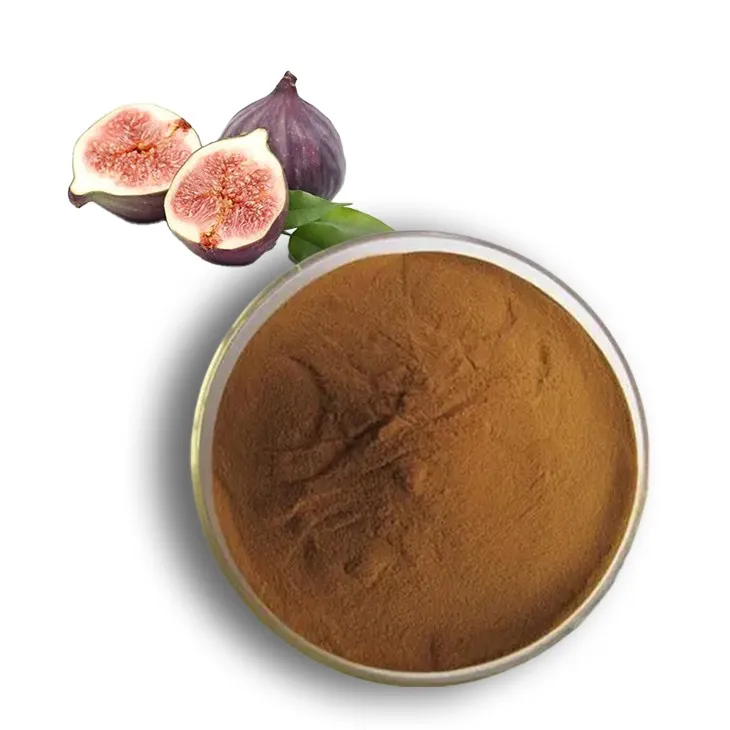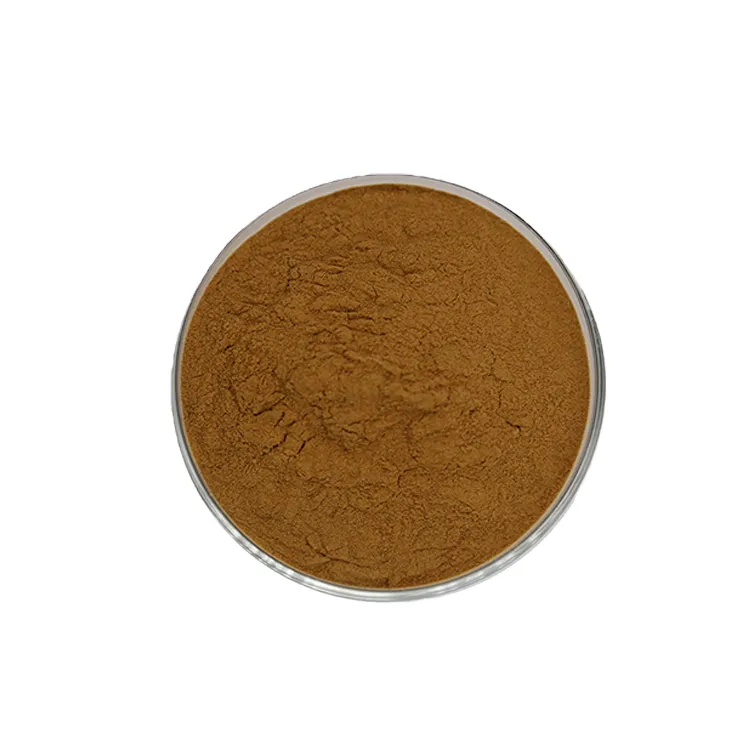- 0086-571-85302990
- sales@greenskybio.com
Extraction process of fig extract.
2024-11-26

1. Introduction
Fig Extract is a valuable substance due to its rich content of various beneficial components. These components can offer numerous health benefits and are also useful in various industries such as food, cosmetics, and pharmaceuticals. Understanding the extraction process of Fig Extract is crucial for obtaining high - quality products. This article will detail the entire extraction process step by step.

2. Raw Material Selection
High - quality figs are the foundation of good Fig Extract. When selecting figs, several factors need to be considered:
-
Maturity: Figs should be fully ripe. Ripe figs tend to have a higher content of the desired compounds. Immature figs may lack the full range of beneficial substances. For example, the flavor and nutritional components in ripe figs are more developed compared to unripe ones.
-
Appearance: Figs should have a good appearance without obvious signs of damage or disease. Figs with bruises or mold may introduce contaminants into the extract, affecting its quality.
-
Source: Figs from a reliable source are preferred. Figs grown in clean and unpolluted environments are more likely to produce high - quality extract. Organic figs, for instance, are often a good choice as they are grown without the use of synthetic pesticides and fertilizers, reducing the risk of chemical residues in the extract.

3. Washing
Once the figs are selected, the first step in the extraction process is washing. Washing is essential to remove dirt and impurities.
The washing process should be thorough:
-
Fresh figs are placed in a clean container or sink filled with clean water. The water should be cool to prevent any damage to the figs.
-
Gently agitate the figs in the water. This can help to dislodge any dirt or debris that may be adhering to the surface of the figs.
-
After a few minutes of agitation, the water is drained, and the figs are rinsed with fresh water. This step may be repeated several times until the water runs clear, indicating that most of the dirt and impurities have been removed.

4. Drying
After washing, the figs need to be dried. Drying can be achieved in two main ways: sun drying or using specialized drying equipment.
4.1 Sun Drying
Sun drying is a traditional method:
-
The washed figs are spread out in a single layer on clean trays or mats. The trays or mats should be placed in a well - ventilated area with direct sunlight.
-
During sun drying, the figs need to be turned regularly. This helps to ensure even drying. Turning the figs also prevents the growth of mold or bacteria, as any moisture trapped in the figs can lead to spoilage.
-
The drying time can vary depending on the weather conditions. In sunny and dry weather, it may take a few days for the figs to dry completely. However, in humid conditions, sun drying may not be the most efficient method, and the use of drying equipment may be preferred.
4.2 Using Specialized Drying Equipment
Specialized drying equipment offers more control over the drying process:
-
There are various types of drying equipment available, such as dehydrators. The figs are placed inside the dehydrator according to the manufacturer's instructions.
-
The drying parameters, such as temperature and air flow, can be adjusted. For figs, a relatively low - temperature drying process is usually preferred to preserve the beneficial components. A temperature range of around 40 - 60 °C is often suitable.
-
The drying time in the equipment is also monitored. Once the figs reach the desired dryness level, as determined by factors such as texture and moisture content, the drying process is stopped.
5. Crushing
After drying, the figs are crushed into a fine powder. Crushing is an important step as it increases the surface area of the figs, making it easier for the solvents to extract the active compounds later.
The crushing process can be carried out using different equipment:
-
Mortar and pestle: This is a traditional method, suitable for small - scale production or laboratory - scale experiments. The dried figs are placed in a mortar, and a pestle is used to grind them into a powder. However, this method can be time - consuming and labor - intensive.
-
Industrial crushers: For large - scale production, industrial crushers are used. These crushers can quickly and efficiently turn the dried figs into a fine powder. Different types of crushers, such as blade crushers or roller crushers, can be selected depending on the specific requirements.
6. Extraction
Once the figs are crushed into a powder, the next step is extraction. Solvents like ethanol or water are used to extract the active compounds from the powdered figs.
6.1 Ethanol Extraction
Ethanol is a commonly used solvent for fig extract extraction:
-
The powdered figs are placed in a suitable container. Ethanol is then added to the container. The ratio of powdered figs to ethanol can vary depending on the desired concentration of the extract. A common ratio could be 1:5 (1 part of powdered figs to 5 parts of ethanol by weight or volume).
-
The mixture is stirred or shaken to ensure good contact between the powdered figs and the ethanol. This helps to dissolve the active compounds in the ethanol.
-
The extraction process may take some time. It can range from a few hours to several days, depending on factors such as the temperature and the nature of the active compounds. Higher temperatures may speed up the extraction process, but care should be taken not to exceed the temperature limits that could damage the active compounds.
6.2 Water Extraction
Water extraction is also an option:
-
Similar to ethanol extraction, the powdered figs are placed in a container, and water is added. The ratio of powdered figs to water also needs to be determined. A ratio of 1:10 may be used in some cases.
-
The mixture is heated to a certain temperature. Water extraction often requires heating to help dissolve the active compounds. However, the temperature should not be too high to avoid boiling the water and causing loss of volatile components. A temperature of around 60 - 80 °C is often suitable.
-
The mixture is stirred during the heating process to ensure uniform extraction. After a period of extraction, which can be several hours, the extract is cooled down.
7. Filtration
After the extraction process, the mixture needs to be filtered to separate the liquid extract from the solid residue.
There are different filtration methods:
-
Filter paper filtration: This is a simple and commonly used method. The extraction mixture is poured through a filter paper placed in a funnel. The liquid extract passes through the filter paper, while the solid residue is retained on the filter paper. However, this method may be slow for large - volume extractions.
-
Vacuum filtration: Vacuum filtration is a more efficient method for larger - scale extractions. A vacuum pump is used to create a negative pressure, which speeds up the filtration process. The extraction mixture is poured into a Buchner funnel with a filter paper, and the vacuum is applied to draw the liquid extract through the filter paper.
8. Purification
The liquid extract obtained after filtration may be further purified through techniques such as chromatography to obtain a more concentrated and pure fig extract.
8.1 Chromatography
Chromatography is a powerful purification technique:
-
There are different types of chromatography that can be used, such as column chromatography or high - performance liquid chromatography (HPLC). In column chromatography, the liquid extract is passed through a column filled with a stationary phase. The different components in the extract interact differently with the stationary phase, and they are separated as they pass through the column.
-
In HPLC, a more advanced form of chromatography, the liquid extract is pumped through a high - pressure system with a very fine - grained stationary phase. This allows for more precise separation of the components in the extract. The separated components can be collected individually, and the desired components can be combined to form a more purified fig extract.
9. Conclusion
The extraction process of fig extract involves multiple steps from raw material selection to purification. Each step is crucial for obtaining a high - quality fig extract rich in beneficial components. With the increasing demand for natural products, understanding and optimizing this extraction process will be of great significance for various industries relying on fig extract.
FAQ:
What are the key steps in the fig extract extraction process?
The key steps include selecting high - quality figs, washing them thoroughly, drying (either in the sun or with drying equipment), crushing into a fine powder, using solvents like ethanol or water to extract active compounds, filtering to separate the liquid extract from the solid residue, and optionally further purifying the liquid extract through techniques such as chromatography.
Why is it necessary to wash the figs before extraction?
It is necessary to wash the figs before extraction to remove dirt and impurities. If not removed, these could contaminate the extract and potentially affect its quality and purity.
What solvents can be used for extracting fig extract?
Ethanol and water are common solvents that can be used for extracting fig extract. These solvents are effective in dissolving the active compounds present in the powdered figs.
How is the solid residue removed during the extraction process?
The solid residue is removed by filtering the mixture of the solvent and the powdered figs. This allows the liquid extract to be separated from the remaining solid matter.
Why might chromatography be used in the fig extract extraction process?
Chromatography might be used in the fig extract extraction process to further purify the liquid extract. It helps to obtain a more concentrated and pure fig extract by separating different components based on their chemical properties.
Related literature
- Optimization of Fig (Ficus carica L.) Extract Production: A Review"
- "The Bioactive Compounds in Fig Extracts: Extraction and Analysis"
- ▶ Hesperidin
- ▶ citrus bioflavonoids
- ▶ plant extract
- ▶ lycopene
- ▶ Diosmin
- ▶ Grape seed extract
- ▶ Sea buckthorn Juice Powder
- ▶ Beetroot powder
- ▶ Hops Extract
- ▶ Artichoke Extract
- ▶ Reishi mushroom extract
- ▶ Astaxanthin
- ▶ Green Tea Extract
- ▶ Curcumin Extract
- ▶ Horse Chestnut Extract
- ▶ Other Problems
- ▶ Boswellia Serrata Extract
- ▶ Resveratrol Extract
- ▶ Marigold Extract
- ▶ Grape Leaf Extract
- ▶ blog3
- ▶ blog4
-
Chinese Withania somnifera Extract Factory.
2024-11-26
-
中国松树皮提取物粉粉末供应商
2024-11-26
-
High - quality Marigold Extract Products.
2024-11-26
-
100% Pure Natural Mango - Flavored Powder.
2024-11-26
-
Diosmin
2024-11-26
-
Tamarind extract powder
2024-11-26
-
Withania Somnifera Extract
2024-11-26
-
Angelica sinensis extract
2024-11-26
-
Lotus leaf extract
2024-11-26
-
Mango flavored powder
2024-11-26
-
Scutellaria Extract
2024-11-26
-
Golden Seal Extract
2024-11-26
-
Echinacea Extract
2024-11-26
-
Giant Knotweed Extract
2024-11-26





















